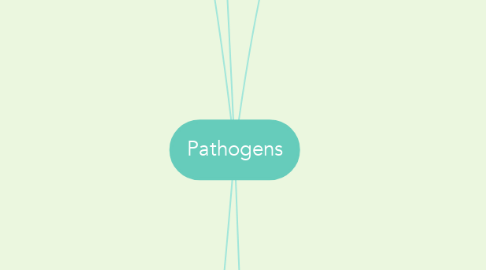
1. Parasites
1.1. Best Prevention Methods
1.1.1. Reputable Suppliers
1.1.1.1. Anisakis simplex
1.1.1.1.1. Commonly linked food
1.1.1.1.2. Common Symptoms
1.1.1.2. Cryptosporidium parvum
1.1.1.2.1. Commonly linked food
1.1.1.2.2. Common Symptoms
1.1.1.3. Giardia duodenalis
1.1.1.3.1. Commonly linked food
1.1.1.3.2. Common Symptoms
1.1.1.4. Cyclospora cayetanensis
1.1.1.4.1. Commonly linked food
1.1.1.4.2. Common Symptoms
2. Fungi
2.1. Best Prevention Method
2.1.1. Monitor your food
2.2. Characteristics
2.2.1. Sometimes makes people sick
2.2.2. Commonly spoils food
2.2.3. Throw out all moldy food unless it's a natural part of the food
2.2.4. Throw away food containing yeast
2.3. Mold
2.3.1. Grows well in almost any condition, esp in acidic food w low water activity
2.3.2. Spoil food and sometimes cause illness
2.3.3. May produce toxins
2.3.4. Are only slowed, not killed by cooler/freezing temperatures
2.4. Yeast
2.4.1. Can spoil food quickly
2.4.2. May produce smell/taste of alcohol as spoils food
2.4.3. Grows well in acidic food with little moisture
2.4.4. May look pink or white discolouration or slime and may bubble
3. Biological Toxins
3.1. Best Prevention Methods
3.1.1. Reputable Suppliers
3.1.1.1. Seafood toxins
3.1.1.1.1. Histamine
3.1.1.1.2. Ciguatoxin
3.1.1.1.3. Saxitoxin
3.1.1.1.4. Brevetoxin
3.1.1.1.5. Domoic Acid
3.2. Sources
3.2.1. Seafood
3.2.1.1. Characteristics of toxins
3.2.1.1.1. Cannot be smelled or tasted
3.2.1.1.2. Cannot be destroyed by freezing or cooking
3.2.1.1.3. Sources in fish
3.2.1.1.4. Sources in shellfish
3.2.2. Plants
3.2.2.1. Toxins
3.2.2.1.1. Can happen when certain plants aren't cooked correctly
3.2.3. Mushrooms
3.2.3.1. Toxins
3.2.3.1.1. Caused by eating wild toxic mushrooms
4. Bacteria
4.1. Characteristics
4.1.1. Found almost everywhere
4.1.2. Cannot be seen, smelled, or tasted
4.1.3. Grows rapidly if conditions are correct
4.1.3.1. Food
4.1.3.2. Acidity
4.1.3.3. Temperature
4.1.3.4. Time
4.1.3.5. Oxygen
4.1.3.6. Moisture
4.1.4. Can produce toxins as they grow and die
4.2. Best Prevention Methods
4.2.1. Reputable Suppliers
4.2.1.1. Vibrio vulnificus & Vibrio parahaemolyticus
4.2.1.1.1. Commonly linked food
4.2.1.1.2. Common Symptoms
4.2.2. Controlling Time & Temperature
4.2.2.1. Listeria monocytogenes
4.2.2.1.1. Commonly linked food
4.2.2.1.2. Common Symptoms
4.2.2.2. Bacillus cereus
4.2.2.2.1. Commonly linked food
4.2.2.2.2. Common Symptoms
4.2.2.3. Shiga toxin-producing E. coli
4.2.2.3.1. Commonly linked food
4.2.2.3.2. Common Symptoms
4.2.2.4. Campylobacter jejuni
4.2.2.4.1. Commonly linked food
4.2.2.4.2. Common Symptoms
4.2.2.5. Clostidium perfringens
4.2.2.5.1. Commonly linked food
4.2.2.5.2. Common Symptoms
4.2.2.6. Clostridium botulinum
4.2.2.6.1. Commonly linked food
4.2.2.6.2. Common Symptoms
4.2.3. Preventing Cross-Contamination
4.2.3.1. Nontyphoidal salmonella
4.2.3.1.1. Commonly linked food
4.2.3.1.2. Common Symptoms
4.2.3.2. Salmonella typhi
4.2.3.2.1. Commonly linked foods
4.2.3.2.2. Common Symptoms
4.2.4. Practicing Personal Hygiene
4.2.4.1. Shigella spp.
4.2.4.1.1. Commonly linked foods
4.2.4.1.2. Common Symptoms
4.2.4.2. Staphylococcus aureus
4.2.4.2.1. Commonly linked foods
4.2.4.2.2. Common Symptoms
4.3. Can turn into spores
4.3.1. Often found in dirt
4.3.2. Can survive cooking temperatures
4.3.3. Can change back into a form that grows
5. Viruses
5.1. Characteristics
5.1.1. Require a living host to grow
5.1.2. Do not grow in food
5.1.3. Can be transferred through food and remain infectious in food
5.1.4. Typically occurs through fecal-oral routes
5.2. Best Prevention Methods
5.2.1. Practicing Personal Hygiene
5.2.1.1. Hepatitis A
5.2.1.1.1. Commonly linked foods
5.2.1.1.2. Common Symptoms
5.2.1.2. Norovirus
5.2.1.2.1. Commonly linked foods
5.2.1.2.2. Common Symptoms
